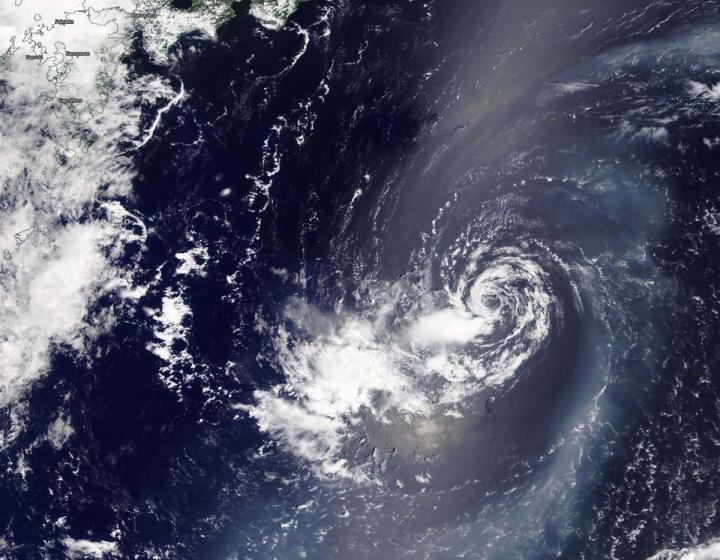
Credit: Credit: NASA/NRL
NASA’s Terra satellite revealed that a wispy looking Tropical Depression 06W in the Northwestern Pacific Ocean was being battered by wind shear. That wind shear is not expected to wane and the storm is expected to weaken.
Tropical Depression 06W formed two days ago on August 9 by 11 a.m. EDT (1500 UTC) near latitude 26.1 degrees north and longitude 147.6 east, about 250 nautical miles east-northeast of Iwo To Island, Japan. 06W briefly strengthened to a tropical storm by 5 p.m. EDT (2100 UTC) when maximum sustained winds reached 45 knots (52 mph/83 kph). By Aug. 10 at 11 a.m. EDT (1500 UTC) the storm had weakened back to tropical depression status.
On Aug. 11, 2020, the Moderate Resolution Imaging Spectroradiometer or MODIS instrument that flies aboard NASA’s Terra satellite provided forecasters at the Joint Typhoon Warning Center in Honolulu, Hawaii with a visible image of Tropical Depression 06W. The image showed a ring of wispy clouds around a fully-exposed, well-defined, low-level center of circulation. It also showed that any precipitation and thunderstorms were pushed to the south-southwest of the center from vertical wind shear.
Vertical wind shear, that is, winds outside of a tropical cyclone at different heights in the atmosphere (the troposphere) push against a tropical cyclone and tear it apart. Winds from the north-northeast were affecting 06W. In addition, dry air was moving into the storm and sapping the development of the thunderstorms that make up a tropical cyclone.
At 5 a.m. EDT (0900 UTC) on Aug. 11, the center of Tropical Depression 06W was located near latitude 26.6 degrees north and longitude 140.5 degrees east, about 681 nautical miles east of Kadena Air Base, Okinawa Island, Japan. 06W was moving to the west and had maximum sustained winds near 25 knots (29 mph/46 kph).
The Joint Typhoon Warning Center (JTWC) forecast notes that 06W will continue to move west and weaken before dissipating after a few days.
About NASA’s Worldview and Terra Satellite
NASA’s Earth Observing System Data and Information System (EOSDIS) Worldview application provides the capability to interactively browse over 700 global, full-resolution satellite imagery layers and then download the underlying data. Many of the available imagery layers are updated within three hours of observation, essentially showing the entire Earth as it looks “right now.”
NASA’s Terra satellite is one in a fleet of NASA satellites that provide data for hurricane research.
Tropical cyclones/hurricanes are the most powerful weather events on Earth. NASA’s expertise in space and scientific exploration contributes to essential services provided to the American people by other federal agencies, such as hurricane weather forecasting.
By Rob Gutro
NASA’s Goddard Space Flight Center
###
Media Contact
Rob Gutro
[email protected]
Original Source
https:/




